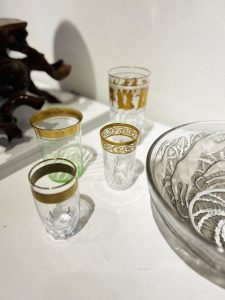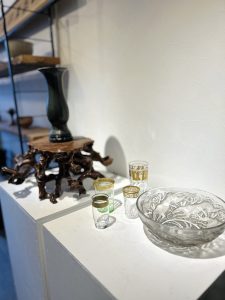新しい場所で輝いております(愛知県名古屋市千種区姫池通 骨とう買取古美術風光舎)
2024.01.21
皆さまこんにちは。スタッフHでございます。
年明けの模様替えにより、店内の雰囲気が少し変わり新鮮に感じられます。置く場所が変わるだけで表情が変わる品もございます。
こちらのグラスたちも照明の下に引っ越しをし、華やかさが増しております。

以前のブログでサンルイ(中央)とモーゼル(手前)のグラスについて調べた時に、ガラスはなぜ透明なのかという説明文がありました。ブログには書きませんでしたが、このキラキラ光るグラスを見ているとまた気になってきました。内容をほぼ忘れておりましたので復習いたしました。
ガラスはなぜ透明なのか端的に説明すると可視光線がすべて通過するからだそうです。では他の物質が光を通過できないのは何故なのかという疑問が起こります。
それは光が物質に当たった時に起こる3つの現象=光の散乱、吸収、透過に関係します。先に言ってしまうとガラスは散乱と吸収をほとんど起こさないのだとか。
散乱は物質表面の微細な凹凸や物質内部の結晶と結晶の隙間(粒界)に光がぶつかり色々な方向へ散らばることです。ガラスの原料は珪砂(けいしゃ)と呼ばれる砂で、1500度で溶かし固めることで作られます。以前のブログでも書きましたが、ガラスは「個体のような液体」=非晶質です。珪砂が持つ粘性という特徴により熱で溶かされた時に水のようにサラサラではなくドロドロの状態になります。そのため冷やし固められた時に氷のように元通りに粒子が綺麗に並ばず、液体の構造のまま固まります。表面の凹凸も内部の結晶も存在しないためガラスは光の散乱を起こさないと考えられています。他に散乱を起こさない非晶質のものにゴムなどがあります。
ではゴムは何故透明ではないかというと、光の吸収が関係します。人が色を判別するとき、それは光の種類を判別していると言えます。バナナが黄色に見えるのは、黄色以外の光の色を吸収する性質があるためです。吸収する色は物質を構成する分子に左右されます。
すべての色を吸収する物質は黒に見え、すべての色を反射する物質は白に見えます。そして全ての色を通過する物質が透明に見えるという仕組みです。
もしガラスが存在しなかったら、どのような世界になるでしょうか。スマホやパソコンなどの通信機器、望遠鏡や顕微鏡などの器具などがなかったらと考えると想像ができませんね。
ガラスの歴史は古く、紀元前5000年頃にはメソポタミアでガラス玉が作れらていたと推定されています。紀元前1世紀、ちょうど日本にガラスが伝わった時期にローマでは細い鉄パイプの先に溶かしたガラスを付け息を吹き込むことで膨らませる「吹きガラス」の技術が発明され、ガラス製品の生産が進化しました。そんなに早くから今に通ずる技術があったことに驚きます。また中国の戦国時代の墓から大量のガラスの器やガラス玉が出土しています。
日本へは漢代に中国から伝わり、弥生時代の遺跡から発見されたガラス玉が最古のものとされています。正倉院にはシルクロードを通ってササン朝ベルシアで製造された円形模様のカットが美しいササングラスである「白瑠璃碗」が収められています。
この透明なガラスに古来より人々が魅了されていたことが想像できますね。
今日は雨で外が薄暗いなか、私もグラスの輝きに見入っております。
それでは、またお会いしましょう。

Hello everyone. This is Staff H.
The atmosphere in the store has changed a little with the redecoration at the beginning of the year, and it feels fresh and new. Some items look different just by being placed in different places.
These glasses have also been moved under the lights and are now more gorgeous.
When I researched the Saint-Louis (center) and Moselle (foreground) glasses in my previous blog, I found a reference to why glass is transparent. I did not write about it in the blog, but I was curious about it again when I saw these sparkling glasses. I had almost forgotten what it said, so I reviewed it.
The simple explanation for why glass is transparent is that all visible light rays pass through it. Then the question arises as to why other materials cannot allow light to pass through them.
It has to do with three phenomena that occur when light strikes a material: scattering, absorption, and transmission. To put it bluntly, glass causes very little scattering and absorption.
Scattering is the scattering of light in various directions when it hits minute irregularities on the surface of a material or the gaps between crystals (grain boundaries) inside a material. The raw material for glass is sand called silica sand, which is made by melting and solidifying it at 1,500 degrees Celsius. As I wrote in a previous blog, glass is a “liquid like an individual” = amorphous. Due to the viscous nature of silica sand, when it is melted by heat, it is not silky like water, but rather a thick slurry. Therefore, when it is cooled and hardened, the particles do not line up as neatly as ice, and it hardens with its liquid structure. Because there are no surface irregularities or internal crystals, glass is considered to be light-scattering-free. Other amorphous materials that do not scatter light include rubber.
The reason why rubber is not transparent has to do with the absorption of light. When people distinguish colors, it can be said that they are distinguishing the type of light. Bananas appear yellow because of their ability to absorb light colors other than yellow. The color absorbed depends on the molecules that make up the substance.
A substance that absorbs all colors appears black, while a substance that reflects all colors appears white. And substances that pass through all colors appear transparent.
What would the world be like if glass did not exist? It is hard to imagine if there were no communication devices such as smartphones and computers, or instruments such as telescopes and microscopes.
Glass has a long history. It is estimated that glass beads were made in Mesopotamia around 5000 BC. In the 1st century B.C., right around the time glass was introduced to Japan, Rome invented the technique of glass blowing, in which molten glass is attached to the end of a thin iron pipe and blown into the pipe to inflate it. It is surprising that the technology that is still used today existed so early. Large quantities of glass vessels and glass beads have been excavated from tombs in China during the Warring States period.
Glass beads were introduced to Japan from China during the Han Dynasty, and the oldest known glass beads were found in ruins from the Yayoi Period. Shosoin contains the “white lapis lazuli bowl,” a beautiful sasanian glass with a circular pattern cut that was manufactured in Sasanian Persia via the Silk Road.
You can imagine that people have been fascinated by this transparent glass since ancient times.
Today, with the outside dimly lit by the rain, I too am gazing at the sparkle of the glass.
Well, I will see you again.
*******************
ご実家の整理やお片付けなどをされている方のご相談などが多くございます。
お片付けなどくれぐれもご無理のないようになさってくださいませ。
風光舎では古美術品や骨董品の他にも絵画や宝石、趣味のお品など様々なジャンルのものを買受しております。
お片付けをされていて、こういうものでもいいのかしらと迷われているものでも、どうぞお気軽にご相談下さいませ。
また風光舎は、出張買取も強化しております。ご近所はもちろん、愛知県内、岐阜県、三重県その他の県へも出張いたします。
まずは、お電話お待ちしております。
愛知県名古屋市千種区姫池通
骨董 買取【古美術 風光舎 名古屋店】
TEL052(734)8444
10:00-18:00 OPEN

